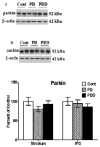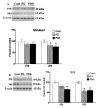Elevated tauopathy and alpha-synuclein pathology in postmortem Parkinson's disease brains with and without dementia
- PMID: 20599975
- PMCID: PMC2922478
- DOI: 10.1016/j.expneurol.2010.06.017
Elevated tauopathy and alpha-synuclein pathology in postmortem Parkinson's disease brains with and without dementia
Abstract
Parkinson's disease (PD), a progressive neurodegenerative disease, results in abnormal accumulation of insoluble alpha-synuclein (alpha-Syn) in dopaminergic neurons. Here we examined tauopathic changes and the alpha-Syn/p-GSK-3beta/proteasome pathway in postmortem striata and inferior frontal gyri (IFG) from patients with PD and PD with dementia (PDD). In both PD and PDD, alpha-Syn levels were high, especially the insoluble form of this protein; in PDD, insoluble alpha-Syn levels were persistently higher than PD across both brain regions. Levels of p-GSK-3beta phosphorylated at Tyr 216, which hyperphosphorylates Tau to produce toxic pathological forms of p-Tau, were higher in striata of both PD and PDD compared to controls, but were unaltered in IFG. While proteasomal activity was unchanged in striatum of PD and PDD, such activity was diminished in the IFG of both PD and PDD. A decrease in 19S subunit of the proteasomes was seen in IFG of PDD, while lower levels of 20S subunits were seen in striatum and IFG of both PD and PDD patients. Parkin levels were similar in PD and PDD, suggesting lack of involvement of this protein. Most interestingly, tauopathic changes were noted only in striatum of PD and PDD, with increased hyperphosphorylation seen at Ser262 and Ser396/404; increases in Ser202 levels were seen only in PD but not in PDD striatum. We were unable to detect any tauopathy in IFG in either PD or PDD despite increased levels of alpha-Syn, and decreased proteasomal activity, and is probably due to lack of increase in p-GSK-3beta in IFG. Unlike Alzheimer's disease where tauopathy is more globally observed in diverse brain regions, our data demonstrates restricted expression of tauopathy in brains of PD and PDD, probably limited to dopaminergic neurons of the nigrostriatal region.
Copyright 2010 Elsevier Inc. All rights reserved.
Figures








Comment in
-
Interaction between α-synuclein and tau in Parkinson's disease comment on Wills et al.: elevated tauopathy and α-synuclein pathology in postmortem Parkinson's disease brains with and without dementia. Exp Neurol 2010; 225: 210-218.Exp Neurol. 2011 Jan;227(1):13-8. doi: 10.1016/j.expneurol.2010.10.006. Epub 2010 Oct 20. Exp Neurol. 2011. PMID: 20965169
References
-
- Adler CH, Hentz JG, Joyce JN, Beach T, Caviness JN. Motor Impairment in Normal Aging, Clinically Possible Parkinson’s Disease, and Clinically Probable Parkinson’s Disease: Longitudinal Evaluation of a Cohort of Prospective Brain Donors. Parkinsonism and Related Disorders. 2002;9:103–110. - PubMed
-
- Arai Y, Yamazaki M, Mori O, Muramatsu H, Asano G, Katayama Y. Alpha-synuclein-positive structures in cases with sporadic Alzheimer’s disease: morphology and its relationship to tau aggregation. Brain Res. 2001;888:287–296. - PubMed
-
- Baum L, Seger R, Woodgett J, Kawabata S, Maruyama K, Koyama M, Silver J, Saitoh T. Overexpressed tau protein in cultured cells is phosphorylated without formation of PHF: implication of phosphoprotein phosphatase involvement. Mol Brain Res. 1995;34:1–17. - PubMed
-
- Burns J, Galvin JE, Roe CM, Morris JC, McKeel DW. The pathology of the substantia nigra in Alzheimer disease with extrapyramidal signs. Neurology. 2005;64:1397–403. - PubMed
Publication types
MeSH terms
Substances
Grants and funding
LinkOut - more resources
Full Text Sources
Other Literature Sources
Medical
Miscellaneous

